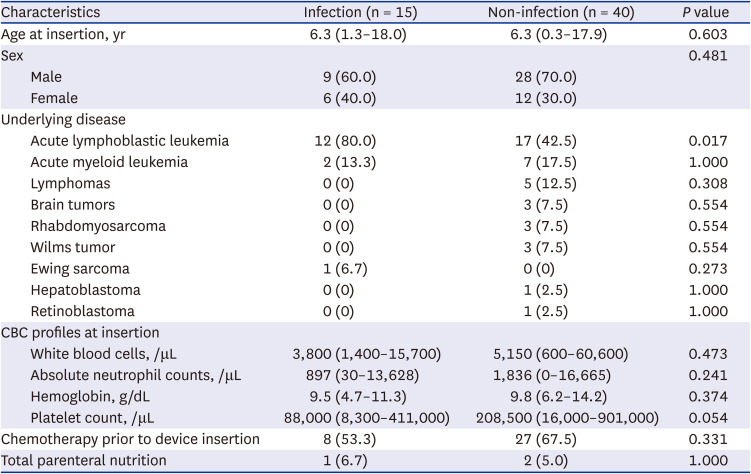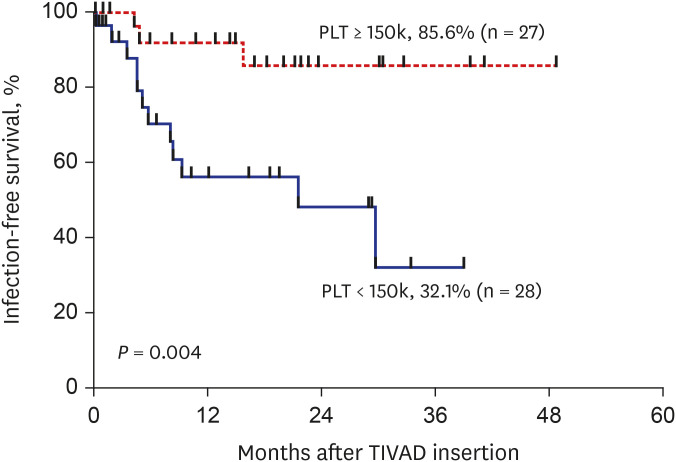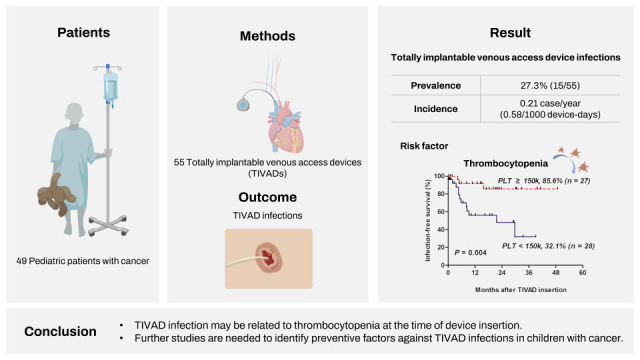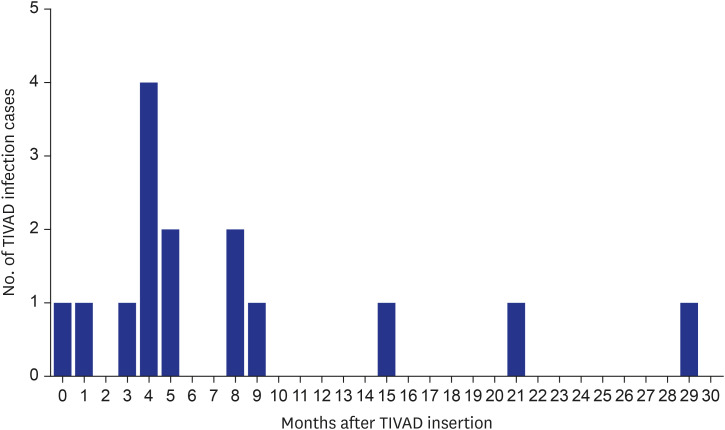1. Stovroff M, Teague WG. Intravenous access in infants and children. Pediatr Clin North Am. 1998; 45(6):1373–1393. viiiPMID:
9889758.

2. Jung SE, Kim YH, Jun YS, Kim DY, Park JK, Lee SC, et al. Totally implantable venous access devices in pediatric surgery patients. J Korean Surg Soc. 1997; 52(3):420–425.
3. Di Carlo I, Cordio S, La Greca G, Privitera G, Russello D, Puleo S, et al. Totally implantable venous access devices implanted surgically: a retrospective study on early and late complications. Arch Surg. 2001; 136(9):1050–1053. PMID:
11529829.

4. Fratino G, Molinari AC, Parodi S, Longo S, Saracco P, Castagnola E, et al. Central venous catheter-related complications in children with oncological/hematological diseases: an observational study of 418 devices. Ann Oncol. 2005; 16(4):648–654. PMID:
15677621.

5. Alexander N. Question 3. Do Portacaths or Hickman lines have a higher risk of catheter-related bloodstream infections in children with leukaemia? Arch Dis Child. 2010; 95(3):239–241. PMID:
20308343.

6. Aparna S, Ramesh S, Appaji L, Srivatsa K, Shankar G, Jadhav V, et al. Complications of chemoport in children with cancer: Experience of 54,100 catheter days from a tertiary cancer center of Southern India. South Asian J Cancer. 2015; 4(3):143–145. PMID:
26942147.

7. Hengartner H, Berger C, Nadal D, Niggli FK, Grotzer MA. Port-A-Cath infections in children with cancer. Eur J Cancer. 2004; 40(16):2452–2458. PMID:
15519519.

8. Tobiansky R, Lui K, Dalton DM, Shaw P, Martin H, Isaacs D. Complications of central venous access devices in children with and without cancer. J Paediatr Child Health. 1997; 33(6):509–514. PMID:
9484682.

9. Ignatov A, Hoffman O, Smith B, Fahlke J, Peters B, Bischoff J, et al. An 11-year retrospective study of totally implanted central venous access ports: complications and patient satisfaction. Eur J Surg Oncol. 2009; 35(3):241–246. PMID:
18329836.

10. Nam SH, Kim DY, Kim SC, Kim IK. Complications and risk factors of infection in pediatric hemato-oncology patients with totally implantable access ports (TIAPs). Pediatr Blood Cancer. 2010; 54(4):546–551. PMID:
19967773.

11. Viana Taveira MR, Lima LS, de Araújo CC, de Mello MJ. Risk factors for central line-associated bloodstream infection in pediatric oncology patients with a totally implantable venous access port: a cohort study. Pediatr Blood Cancer. 2017; 64(2):336–342. PMID:
27666952.

12. Gyves J, Ensminger W, Niederhuber J, Liepman M, Cozzi E, Doan K, et al. Totally implanted system for intravenous chemotherapy in patients with cancer. Am J Med. 1982; 73(6):841–845. PMID:
6959532.

13. Deerojanawong J, Sawyer SM, Fink AM, Stokes KB, Robertson CF. Totally implantable venous access devices in children with cystic fibrosis: incidence and type of complications. Thorax. 1998; 53(4):285–289. PMID:
9741372.

14. Al-Bassam A, Al-Rabeeah A, Fouda K, Al-Ashwal A, Ozand PT. Implantable central venous access devices in children with metabolic disease. Metabolism. 1998; 47(8):900–902. PMID:
9711982.

15. Beck O, Muensterer O, Hofmann S, Rossmann H, Poplawski A, Faber J, et al. Central venous access devices (CVAD) in pediatric oncology patients—A single-center retrospective study over more than 9 years. Front Pediatr. 2019; 7:260. PMID:
31294007.

16. Lebeaux D, Fernández-Hidalgo N, Chauhan A, Lee S, Ghigo JM, Almirante B, et al. Management of infections related to totally implantable venous-access ports: challenges and perspectives. Lancet Infect Dis. 2014; 14(2):146–159. PMID:
24314751.

17. Pinelli F, Cecero E, Degl’Innocenti D, Selmi V, Giua R, Villa G, et al. Infection of totally implantable venous access devices: a review of the literature. J Vasc Access. 2018; 19(3):230–242. PMID:
29512430.

18. Miliaraki M, Katzilakis N, Chranioti I, Stratigaki M, Koutsaki M, Psarrou M, et al. Central line-associated bloodstream infection in childhood malignancy: single-center experience. Pediatr Int. 2017; 59(7):769–775. PMID:
28376269.

19. Mermel LA, Allon M, Bouza E, Craven DE, Flynn P, O’Grady NP, et al. Clinical practice guidelines for the diagnosis and management of intravascular catheter-related infection: 2009 update by the Infectious Diseases Society of America. Clin Infect Dis. 2009; 49(1):1–45. PMID:
19489710.

20. Wolf J, Allison KJ, Tang L, Sun Y, Hayden RT, Flynn PM. No evidence of benefit from antibiotic lock therapy in pediatric oncology patients with central line-related bloodstream infection: results of a retrospective matched cohort study and review of the literature. Pediatr Blood Cancer. 2014; 61(10):1811–1815. PMID:
24923808.









 PDF
PDF Citation
Citation Print
Print





 XML Download
XML Download